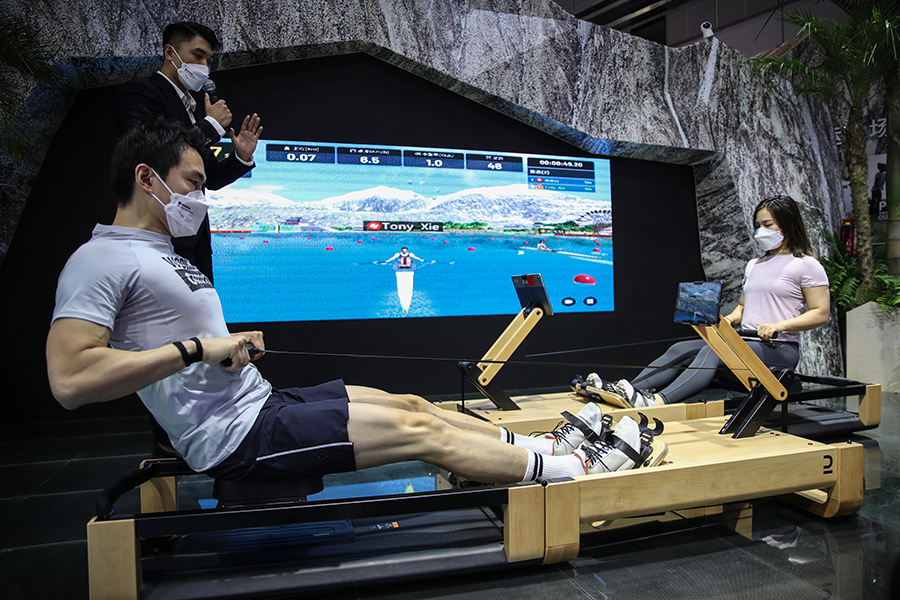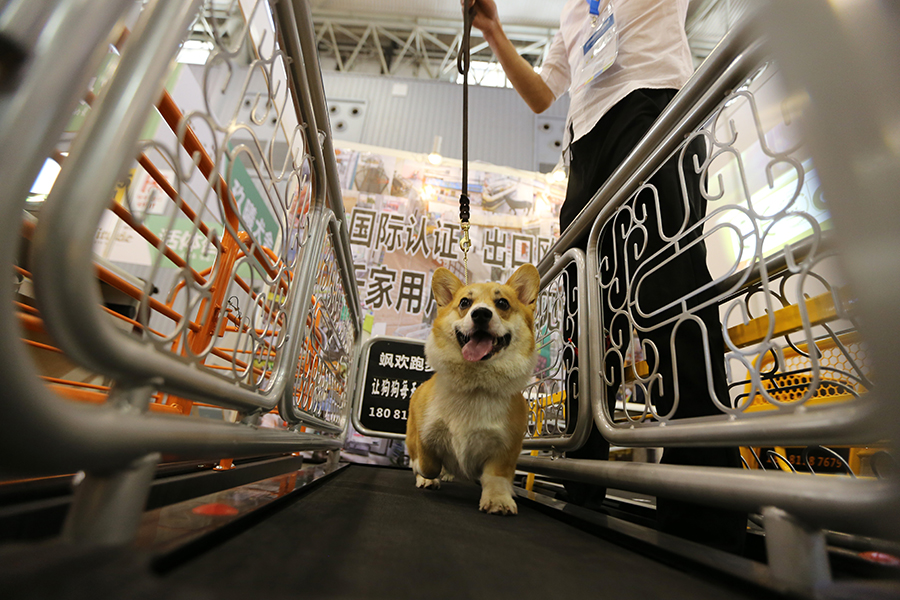By FAN FEIFEI | China Daily | Updated: 2023-01-27 07:07

Visitors check out an indoor rower during the fifth China International Import Expo in Shanghai in November.
[PHOTO by ZHANG HENGWEI/CHINA NEWS SERVICE]
Online channels spur sales, with shoppers more concerned about safety and health
Feng Yuchen, a 33-year-old financial magazine editor in Beijing, has frequently trawled mobile apps and filled her e-shopping carts with a range of products since the COVID-19 pandemic emerged.
Her purchases include a yoga mat, a treadmill, sportswear, high-end skincare products and nutrition supplements.
“I prefer to buy what is needed via online shopping, which is a lot of fun. I like to buy all sorts of fitness and healthcare products for my family,” Feng said.
Her main goal is to maintain her quality of life as much as possible, and she has downloaded several fitness apps. She also exercises at home to stay in good shape, and improve her image and temperament.
Like Feng, hundreds of millions of Chinese consumers can vouch for the efficiency and reliability of the burgeoning e-commerce sector. The nation’s middle- and high-income shoppers demand increasingly high-quality, diversified and personalized products and services via online marketplaces, according to industry insiders.
Online shopping has injected new impetus into China’s consumption, which plays a fundamental role in the country’s economic development and is the main driving force boosting economic growth, the insiders added.
According to a report released by e-commerce platform JD, Chinese consumers tend to pursue flexible and sustainable lifestyles to better cope with mounting uncertainties, and they expect online shopping to bring spiritual comfort and forge emotional connections with others.
The report said more young people in urban areas have started to grow vegetables on their balconies as a hobby to help alleviate pressure. Sales of intelligent vegetable planters and vegetable seeds on JD’s online marketplaces surged by 70 percent and 60 percent year-on-year, respectively, in 2022.
Demand is growing fast for specialized food storage and management products among this group of consumers, with the turnover of vacuum sealers, which remove air from food storage bags to ensure flavor and freshness, rocketing by 250 percent year-on-year, the report said.
Consumers are also paying more attention to their personal feelings by aiming to establish stronger emotional ties, especially with pets. The transaction volume for pet training treadmills rose more than eightfold last year, while sales of cat houses with a small coffee table quadrupled compared with a year earlier.
During the pandemic, sales of fitness equipment have risen, with people who are staying at home keener to remain in shape.
Turnover of intelligent fitness mirrors that detect body movements and gestures through artificial intelligence-powered technology, and fitness mats soared by 160 percent and 650 percent, respectively, on a yearly basis last year.
Health concerns
The JD report said Chinese shoppers are also attaching greater importance to health and personal image management, with personal care, beauty, smart-home and healthcare products gaining popularity.
For instance, sales of scalp scrubs that help cleanse and calm an itchy scalp, and intelligent products such as special headphones designed to induce sleep, rose by 200 percent and 150 percent, respectively, last year compared with 2021.
Wang Yun, a researcher at the Academy of Macroeconomic Research, which is affiliated with the National Development and Reform Commission, the country’s top economic planner, said: “Chinese shoppers are more concerned about safety and health, and they prefer to buy high-quality products, as well as enjoy services that make their life safer and more comfortable. Health-related commodities, including nutrition products, medicine and fitness equipment, have been increasingly favored by consumers.”
Chinese consumers have also become more rational, and are carefully reviewing their needs, with a key focus on the quality and value of the products they buy, as well as the feelings that services bring to them, Wang said.

With the adoption of continuously optimized COVID-19 prevention and control measures, China’s consumer market has witnessed a notable recovery, Wang said, adding that she is optimistic that consumption momentum will be maintained this year, with the growth rate expected to reach more than 6 percent.
Liu Hui, director of JD’s Consumption and Industry Development Research Institute, said tech-savvy members of Generation Z -people born between the mid-1990s and the early 2010s — are emerging as mainstream consumers and the major force driving the growth of new products.
Brand owners and manufacturers are increasingly placing greater emphasis on purchasing demand among the post-1995 generation, and are customizing new products especially for this group, Liu said.
At last month’s tone-setting Central Economic Work Conference in Beijing, it was decided that this year China will focus on boosting domestic demand by prioritizing the recovery and expansion of consumption.
Analysts said the consumption recovery will be the main force boosting the nation’s economic rebound in 2023, with local governments across the country recently accelerating steps to boost consumption by distributing shopping vouchers.
For example, the authorities in Shenyang, capital of Liaoning province, have launched a 100-million-yuan ($14.8 million) voucher campaign from Jan 10 to Feb 28 to boost sales of automobiles and home appliances.
On Jan 11, the authorities in Tianjin began distributing shopping coupons worth a total of 115 million yuan, while Beijing’s Fangshan district announced the issuance of 1 million consumption vouchers to encourage spending in the cultural and tourism sector from Jan 11 to Feb 2.
Back on track
Wu Chaoming, deputy director of the Chasing International Economic Institute, said the continued optimization of COVID-19 policies will significantly bolster consumption growth and stimulate residents’appetite to travel and spend this year.
Per capita consumption expenditure among Chinese residents is expected to grow between 8 percent and 12 percent this year compared with 2022, while retail sales of consumer goods, a vital consumption indicator, will increase between 7 percent and 11 percent, Wu estimates.
Justin Koh, senior vice-president at global consulting company AlixPartners, said: “We anticipate the resumption of travel, starting with the Chinese Lunar New Year holiday. The number of international flights will rise in the second quarter of this year, which is expected to help boost leisure and business travel both at home and abroad.”
A report released by global consultancy Accenture showed that with rising living standards and the availability of more services, Chinese people tend to pursue a better work-life balance and will pay for convenience, which has accelerated the growth of online shopping channels.
When making a shopping decision, consumers are inclined to care about their own needs and preferences, rather than the perspectives and comments of others, the report stated.
Consumers have a strong desire to try new things, as they are open to using digital technologies — evidenced by the way in which they have embraced a variety of intelligent devices, ranging from smartphones to smart homes.
The report noted that in the long run, fully tapping consumption potential and upgrading channels and services in lower-tier cities and rural areas will remain key measures to fuel China’s consumption recovery.
Eric Hor, managing director of Accenture Strategy and Consulting Greater China, said the pandemic has fundamentally altered Chinese consumers’ consumption philosophies by making them more restrained and pragmatic.
“In addition to restraining their shopping impulses and reducing unnecessary expenditure, people have begun to conduct in-depth research and thorough comparisons before deciding what to buy, and they regard the selection process as an integral part of the consumer experience,” he said.
Jennifer Ye, consumer markets leader for PwC Chinese mainland, said the “stay-at-home economy” has spurred rapid growth in online shopping and digital enablement. This growth has propelled the integration of online and offline consumption scenarios in China, with personalized, high-end and trendy brands and products favored by shoppers.
With the transformation and upgrading of China’s manufacturing industry, the guochao trend, which features fashionable designs mixed with elements from traditional culture, is gaining popularity among young Chinese consumers, Ye said.
Zhao Ping, deputy head of the Academy of China Council for the Promotion of International Trade, which is based in Beijing, said:”China boasts a sizable consumption market, with immense development potential and resilience. The top priority to stabilize economic growth lies in maintaining stable consumption growth.”
She called for efforts to encourage enterprises to use new-generation information technologies such as big data, cloud computing and artificial intelligence to create new types of green and intelligent consumer goods and cultivate new consumption growth points.

